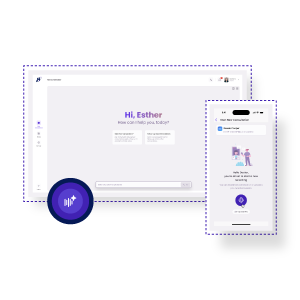By 2025, AI will be voice-controlled, and it will help with your morning routine or the documentation related to a patient during clinical encounters. We do not only want weather and playlist information. We want intelligent machines to take medical notes, schedule appointments, and remind patients about patient rechecks, and they have done it in real-time.
This blog samples how this voice-actuated AI is developing, its implementation areas, and how it is transforming how professionals (notably in the healthcare sector) can operate with their devices.
What Is Voice-Activated AI?
In essence, voice-activated AI allows the person to operate a machine via ordinary speech. You have said something. It listens, comprehends, and takes action. Voice software is becoming intelligent. They are not mere responders to orders, but they work in context, they can remember previous behaviors, and engage in entire conversations. It would imply a greatly reduced number of wake words, less repetition of phrases, and a whole lot of productive interaction.
Research has shown that voice AI scribes are accurate in clinical documentation to the extent of 94-96 percent, which is much higher than the conventional physician notes, which tend to omit crucial information about 20-30 percent of the time. The transcription mistakes with such an AI-led system are also decreased by up to 47%, and data integrity and compliance are enhanced.
Top Use Cases for Voice-Activated Tools in 2025
That is where voice-activated AI plays the most significant role:
- At-home: Switching off the lights, regulating thermostats, locking doors, and making grocery lists
- On the go: Send a text message, find directions, run your calendar without hands
- In the workplace: Preparing notes and making meetings, launching a presentation
- In care: Recording SOAP Notes, writing AI medical notes, scheduling, and AI medical billing support
How Healthcare Pros Are Using Smart Voice Assistants?
Let’s zoom in on healthcare for a second. Most doctors don’t need another app. What they do need is a way to see more patients without spending their evenings buried in charts.
Enter smart voice assistants built specifically for clinical use, like the one from HealthOrbit AI.
This assistant doesn’t just take voice commands. It listens quietly during consults and builds accurate SOAP Notes in real time. It can even suggest billing codes and follow-ups—all while the clinician stays fully engaged with the patient.
Why is it working?
- No toggling between screens
- No after-hours charting marathons
- More natural patient interactions
- More complete, accurate documentation
Doctors who’ve adopted this tech are reporting serious time savings—10+ hours a week in some cases.
The Rise of Voice Assistant Devices in Workspaces
Smartphones are no longer the only home for voice tech. In 2025, we’re seeing dedicated voice assistant devices pop up in:
- Clinics
- Meeting rooms
- Operating theaters
- Reception areas
- Even in ambulances
These devices are designed to respond fast, work hands-free, and stay secure. In medical settings, some are even embedded with Ambient Technology—meaning they’re always listening (within compliance), ready to step in when needed.
Voice Tech + Billing: The Underrated Power Move
Documentation is great. But you know what matters just as much? AI medical billing.
Healthcare providers lose billions every year due to billing errors or missed documentation.
By capturing accurate, real-time notes with voice-activated AI, billing becomes:
- Cleaner
- Faster
- More accurate
- Easier to audit
Tools like HealthOrbit AI connect SOAP Notes directly to billing workflows, so nothing falls through the cracks. The result? Fewer rejections, faster reimbursements, and more time for actual care.
Why HealthOrbit AI Is the Go-To Choice for Healthcare Voice Assistants?
There are plenty of smart voice assistants out there. But very few are built specifically for healthcare. HealthOrbit AI stands out because it’s:
- Designed with real clinicians in mind
- Fully HIPAA-compliant
- Built to capture structured SOAP Notes in real time
- Integrated with scheduling and billing tools
- Powered by Ambient Technology for hands-free documentation
If you’re looking to cut down admin, improve note quality, and reduce burnout, this is the one to try.
Quick Comparison: Voice Tools at a Glance
| Your Need | Top Pick |
| Everyday tasks & reminders | Google Assistant |
| Smart home automation | Amazon Alexa |
| Full clinical documentation support | HealthOrbit AI |
| Samsung device users | Bixby |
| Hands-free device control | Google Voice Access |
Final Thoughts
Voice-activated AI has come a long way from just setting alarms or playing music. In 2025, it’s reshaping how we live, work, and care for others.
For everyday users, it’s about convenience. For healthcare professionals, it’s about survival—cutting hours off paperwork, making documentation cleaner, and helping deliver better care.
With smart voice assistants like HealthOrbit AI, that help is finally hands-free, fast, and reliable.
FAQs
What is voice-activated AI?
Voice-activated AI allows you to control smart devices using natural speech. It’s used in phones, assistants, medical tools, and more.
Can voice assistants take medical notes?
Yes. Tools like HealthOrbit AI capture SOAP Notes in real time while you speak with the patient—no typing needed.
Are voice assistant devices secure in healthcare?
Only some are. HealthOrbit AI assistant is HIPAA-compliant and designed specifically for clinical documentation and billing.
What’s Ambient Technology in voice tools?
It means the assistant listens in the background and responds without needing a wake word. It’s passive, smart, and less disruptive.
How does voice AI help with medical billing?
By capturing complete and accurate documentation it reduces billing errors and improves reimbursement timelines.




